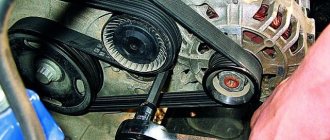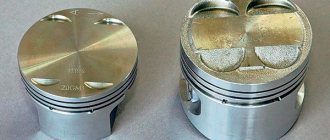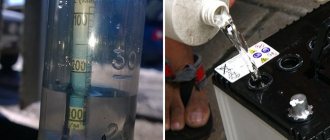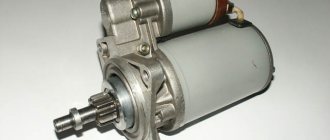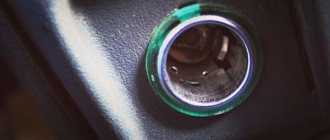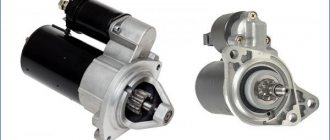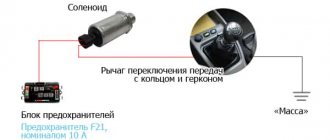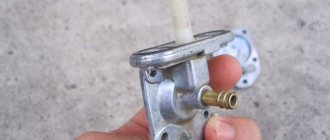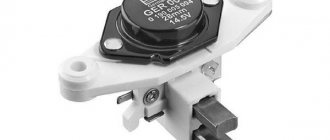The main nuances of the functioning of the timing belt in cars
It is extremely important to understand that the rubber timing element is responsible for transmitting the timing gear in the motor shafts.
The latter, in turn, are responsible for the timing of the air-fuel mixture in the cylinders of the power unit. If the timing belt has jumped or it has broken, the entire timing system begins to function differently. All this is manifested by shifts and malfunctions of the most important component of the car - its engine. It was written in detail above that in these cases the power of the power plant necessarily decreases, fuel consumption increases and starting deteriorates.
In addition, slippage or rupture of the timing component can cause failure of the piston-valve group in the engine. When the belt breaks, the valves open towards the piston, which leads to internal engine problems.
Monitoring the condition of the timing belt is a guarantee of preventing severe consequences for the power plant
But it is important to be able to control not only the appearance of the belt, but also the degree of tension. On their own, which is quite natural, it will be extremely difficult for a person with non-professional skills to diagnose the correct installation of the belt
In order not to make a mistake, you need to pay attention to the service life of the belt and the condition of the parts accompanying the operation of the element. In particular, ensuring the degree of tension and uninterrupted operation
The period for replacing the most important timing part may vary. It depends on the specific car manufacturer. In addition, it is necessary to take into account such an indicator as the originality of the part. It is clear that “left” companies can easily produce defective belts or belts with a reduced service life.
It is also important to understand that on the modern market you quite often find parts of the universal type rather than the standard one. What does it mean? It's simple - universal parts, belts in this case, are not made for a specific car
They are not a priori characterized by good quality, and although they are cheaper than the original ones, they are not recommended for purchase.
You can distinguish an original belt from a universal one (there are several effective ways). If the part is universal, then to determine the service life of the belt and its replacement, you will have to take this into account. In other words, if the manufacturer indicated that the belt can last 70 thousand kilometers on his car, this does not apply to the universal one. This one will definitely last less.
As mentioned above, the service life of the belt on front-wheel drive VAZs is approximately 60-70 thousand kilometers. If the car was purchased secondhand, you should not trust its owner who claims that the belt is new, there will be no problems with it.
When choosing a new timing belt for your car, it is recommended to pay great attention to the material. If there are no marks left on the rubber after several folds in and out, most likely, everything is fine with the material
But on the contrary, if even the slightest microcracks are noticed, it is better not to buy such a belt right away.
It is also recommended to check the belt model number with the number specified in the operating manual for a specific vehicle. The numbers are unlikely to match; it is a great success if such a belt can be found. But you can check belts in another way: by comparing the length, width and thickness of the old factory belt and the new analogue.
The belt must also be checked around its entire circumference. If protruding threads are noticeable on the ribs, the cord will be visible, it is better to immediately abandon this option.
If you do not have the appropriate skills and ability to work with your own hands, it is better to entrust replacing the timing belt to professionals. Without a doubt, a seemingly simple operation at first glance can fray your nerves and take a lot of effort. And most importantly, an illiterate replacement can lead to even bigger problems.
Of course, in a big city it will be easier to find a quality car service among the many options. In rural areas, you have to rely on the honesty of service station workers or carry out this event yourself
The most important thing is that it doesn’t matter which method was chosen, what’s more important is to save time and money, getting the highest quality result
- Absolutely legal (Article 12.2);
- Hides from photo and video recording;
- Suitable for all cars;
- Works through the cigarette lighter connector;
- Does not cause interference to radios and cell phones.
The timing belt has an important function in the operation of the vehicle's power plant. But like any part, it can periodically malfunction. The situation when the timing belt has jumped is familiar to many car enthusiasts. It may jump one or more teeth on the pulley. This may cause vehicle damage.
What is a timing belt for?
The timing belt is a rather complex unit in terms of design. It is based on a camshaft located in the cylinder head. With its help, the intake and exhaust valves are pushed. The valves, in turn, ensure the supply of a combustible mixture to the engine cylinders, and also help remove gases from the vehicle system. The operation of the camshaft is possible due to the presence of a crankshaft in the system. Thus, the mechanical force from the second to the first is transmitted using a drive belt.
A malfunction of the camshaft drive will disrupt the gas exchange process in the cylinders. The engine will not be able to function normally, and this is fraught with serious consequences for the main power unit
The belt is subject to temperature and mechanical influences; it is logical that sooner or later it will wear out. It stretches and cracks form on its surface, which negatively affects the operation of the entire system. Its slippage will affect the functioning of the valves: they will stop opening at the moment corresponding to the engine operating cycles. But the breakage of a rubber product is much more dangerous. During a break, the gas distribution mechanism remains inactive, therefore, the valves do not close until the piston rises, an impact occurs, after which the valves themselves bend, and defects form on the piston.
Repair cost
The average price for replacing a belt and roller in car services ranges from one to three thousand rubles. The price range is due to the fact that replacing parts on foreign cars costs approximately 2–3 times more than on domestic cars.
If it turns out that you also need to change the engine water cooling pump and the crankshaft oil seal, then the price will increase by another 1 - 1.5 thousand rubles.
Although there is a huge selection of products on the market at different price levels, you should only choose brands recommended by the manufacturer or their high-quality analogues. Using cheap parts can lead to serious damage and expensive repairs.
For example, if the valves are bent as a result of a belt slipping, then almost the entire cylinder head will have to be replaced. Even if the repair is carried out by yourself, the cost of replacing valves, pump, belt, filling oil and antifreeze, and other parts will be at least 10,000 rubles.
Source
The timing belt jumped onto a tooth of a VAZ car: signs, symptoms and repair methods
Like any other car component or part, the timing belt performs certain functions. It is entrusted with a significant option, and due to the convincingness of its functioning, the operational duration and security of the automotive power plant as a whole is determined.
Can the timing belt jump?
Author's note: Jumping or slipping of the timing belt is a fairly common phenomenon familiar to many motorists. The belt slips one tooth or several. We are talking about the teeth of the crankshaft or camshaft flywheel. It is clear that such a situation can lead to serious problems.
The main reasons why the timing belt jumps
This is how a timing belt works
The timing belt is an important element of the car, so it needs to be serviced promptly. The reasons that lead to its jump are the following:
- Contact of oil or cooling liquid on the belt surface
- Improper use
- Late replacement
- External damage
- Incorrectly placed labels
- Difficult operating conditions
- Low quality spare parts
Of course, these are not all cases due to which the timing belt breaks or jumps. But this can be understood by the following signs.
Signs and Symptoms of a Timing Belt Jumping
In internal combustion engines that use a timing belt in the timing drive, there is always the danger of it jumping over one or more teeth.
If the timing belt has jumped, the signs of this, depending on the design of the engine, may be the following:
- Unstable engine operation
- The engine stalls
- Power Loss
- Poor startup or inability to start at all
- Engine wedge
Author's Notes: As a rule, if the timing belt jumps within two teeth, the engine will continue to run, but with visible interruptions. When the belt jumps more than two teeth, the consequences can be very different.
Using front-wheel drive vases as an example, the following happens:
- 1.1 and 1.3 liter engines there will be a meeting of valves with pistons with all the ensuing consequences;
- 1.5 and 1.6 liter engines the valves remain intact, but the engine begins to behave inappropriately.
- on some models of modern engines, the valves remain intact, but the rocker breaks, which makes subsequent repairs cheaper.
A similar malfunction, such as a timing belt that has jumped, is usually caused by either an oil leak that has reached the belt teeth, an antifreeze leak, a faulty tension roller, or extreme belt wear.
What to do if your timing belt has jumped one or more teeth
As a rule, a timing belt jump does not immediately lead to extreme problems, but the engine begins to function intermittently or does not start. The explanation is simple: the gas protection phases are incorrect, the general cycle of fuel supply and cylinder cleaning is disrupted.
Timing belt assembly with rollers
The reason for timing belt jumping is often due to the fact that a little oil or coolant drips onto the rubber material of the timing element. The pump is leaking, the cuff of any shaft is malfunctioning - in a word, anything related to oil or liquids can lead to this. Therefore, if you find a malfunction, you must do the following:
When inspecting the engine, oil leaks will be visible on the timing belt cover, so when opening the hood to check the oil level, you should always pay attention to the cleanliness of this cover. If the belt cover has no visible traces of oil, and the engine operation has changed dramatically, you need to remove the cover and check the alignment of the marks and the tension of the timing belt. When traces of oil are found, it is necessary to remove the cover and carefully inspect the belt and find the location of the oil leak. This could be crankshaft or camshaft seals, a leaking pump, or, for example, a leaking oil pressure sensor on VAZ 2108-09 engines and their families
The sensor is located just above the belt cover (top left) and when it is squeezed out, the oil flows just under the belt cover. In such a situation, it is necessary to replace the failed parts and if the timing belt is in oil, then replace the belt as well. After removing the timing belt, it is necessary to clean all parts from traces of oil. When replacing a belt, try to set the marks as accurately as possible, since a belt that is “knocked down” by one tooth will certainly affect the operation of the engine and its starting. This especially applies to diesel engines, which are the most demanding in terms of matching valve timing. If the design does not provide an automatic roller tensioner, then it is necessary to check the belt tension.
Symptoms of malfunction
The main signs that the belt or chain has slipped:
- change in throttle response, power, engine torque;
- increase in the toxicity of exhaust gases, their shade;
- problems when starting the engine;
- a “check engine” error message appears on the dashboard;
- the occurrence of extraneous noise of a non-metallic (for belt drive) and mechanical nature (for both chain and belt drives).
If such signs appear, you should stop driving (start the engine), have the engine diagnosed, or contact a mechanic.
This is how a timing belt works
The timing belt is an important element of the car, so it needs to be serviced promptly. The reasons that lead to its jump are the following:
- Contact of oil or cooling liquid on the belt surface
- Improper use
- Late replacement
- External damage
- Incorrectly placed labels
- Difficult operating conditions
- Low quality spare parts
Of course, these are not all cases due to which the timing belt breaks or jumps. But this can be understood by the following signs.
Gentlemen, has anyone had cases where the belt was not on the marks by 1-2-3 teeth? What are the symptoms and how does it manifest itself in operation? Troits, knocks, rings? Otherwise, there are suspicions after the replacement.
on 3S something like that. With just one tooth, the car started with half a kick, but when you pressed the gas pedal there was a ringing sound in your fingers. My father-in-law's Crown 1G refused to start at all)))
When pressing the gas at idle or while driving? I just get a ringing sound when I move and lightly press the gas.
What's stopping you from removing the covers and checking the marks? If everything is fine, then the electrician needs to set the ignition with a strobe light (in this case, a jumper is placed in the diagnostic connector between Te1 and e1)
both in place and on the move
I really appreciate your participation and admit that I did not provide complete information about the car. You see, I have a 7A-LB engine and the ignition on it is not adjustable. In addition, having worked as a diagnostician myself (albeit for Volvos), I would not have asked a respected forum for help if everything was so simple.)
Wow, this is not my case, I only have it while moving and only with a fully warmed up engine.
I'm waiting for more comments)
By the way, the same canoe after replacing the timing belt, according to the marks, everything is correct, I removed the cover twice, but the ignition stops earlier, I feel it, detonation appears too often. When the heat is not scary, but when frosts start, there may be problems with starting. Even if you fill the gasoline with 98, it still makes a jingling sound. And the tooth here and there won’t be anything terrible, just not big problems. On the jig, I specially threw the chain over one tooth when I went long distance, it ran more fun.
It’s very wrong for you to think so about a mistake of one tooth. Yes, it will start without problems even by 2-3 teeth, but it won’t drive normally even with a mistake of one tooth or it will start guzzling fuel like crazy. Zhiguli is not an example, you know why. And what are the problems, check the installation of the timing belt, there are a lot of books there, everything is simply described there, or ask someone who knows.
By the way, as an option, detonation occurs from severe coking of the CPG, then detonation is practically invincible without drastic measures.
Causes
The timing belt is an important element of the car, so it needs to be serviced promptly. The reasons that lead to its jump are as follows:
Contact of oil or cooling liquid on the belt surface
As soon as traces of technical fluid appear on the product, the belt should be changed immediately. Otherwise, this can lead to slipping through the teeth, sliding off the pulley, and even breaking.
It is a serious mistake when drivers simply clean the dirty surface and continue to use this product.
Practice shows that if liquid gets on the belt, it is completely absorbed into the rubber. It loses its properties and begins to stretch.
Late replacement
Most timing belt manufacturers recommend changing their products approximately every 60 thousand kilometers. However, this figure may vary up or down, depending on the quality of the product.
Improper use
It happens that a product may jump due to errors during its operation. A common example is a weakened roller or tensioner. When the belt tension weakens, there is a possibility of slipping from the pulley grooves. In the opposite situation, if when installing the belt, it is overtightened, this will lead to its breakage.
Slippage can also occur when one of the pulleys has strong play
Therefore, it is very important to monitor the tension level of all parts of the mechanism.
The labels are set incorrectly
Sometimes the jump is not visible outwardly, but the engine does not start well and immediately stalls. This can happen if the marks were knocked down or incorrectly set initially. A shift of even one tooth can cause problems with the motor. If the engine is diesel, it will not start even if there is an error of one tooth.
It is necessary to replace the timing belt in safe places using special tools.
This photo shows that the intake is offset by one tooth clockwise; this is one of the most common mistakes when replacing a belt. To prevent this from happening, you can use special pulley clamps when replacing the timing belt.
External damage
Over time, various cracks and depressions may appear on the surface of the consumable, and the threads of the product may begin to peel off. With heavy loads on the belt, even the smallest defects will develop quite quickly. Therefore, they cannot be eliminated on your own. All you can do is replace it as soon as possible.
Low quality spare parts
There are very cheap “non-original” belts on sale. But don't be fooled by their price. Often the resource of such a product is only enough for 20 thousand kilometers. This is followed by either stretching or breaking.
Difficult operating conditions
Unlike a chain, a belt is very sensitive to high and low temperatures, high humidity and other weather conditions. They affect premature wear of the product. Therefore, more frequent replacement may be required.
Belt tightened/understretched
One of the most common mistakes when replacing this element of the gas distribution mechanism yourself is incorrect tension:
- A belt that is too tight can break when the engine is running. This threatens large-scale breakdowns of the valve-piston group of the power unit.
- On the other hand, insufficient tension can lead to the belt slipping at high engine speeds.
To check the correct tension, try to rotate the long part of the belt 90 degrees. The correctness of the state is indicated by an average effort, when it is not required to act too hard or lightly on this element.
How to correctly set marks during the process of replacing/installing a belt on a “nine”
The timing belt on cars with front-wheel drive is carried out using a toothed belt. Each successive replacement of the AvtoVAZ belt is recommended after 65,000 miles. In addition to replacing the element itself, it is also recommended to change the roller.
The algorithm for replacing the timing belt is as follows:
- First of all, a new belt and roller are purchased (it is advisable that both elements are recommended by the car manufacturer);
- The car is placed on a level surface;
- The battery is de-energized (due to the exception of a short circuit during the work process);
- The car is secured with special anti-rollback stops;
- The protective cover is removed from the timing system;
- The power unit is set according to the marks.
How the marks are set
It is important to be able to set the marks so that in the front part of the engine the mark on the camshaft wheel coincides with the upper boss on the belt cover. As for the second mark, it is connected to the clutch cover hatch
It is located under the distributor. This hatch is protected by a special rubber plug, which must be pulled out. And if the marks are set correctly, you should check the mark on the hatch: if in the triangle of the hatch you can see a mark that coincides with the end of the flywheel, then everything is correct
As for the second mark, it is connected to the clutch cover hatch. It is located under the distributor. This hatch is protected by a special rubber plug, which must be pulled out. And if the marks are set correctly, you should check the mark on the hatch: if in the triangle of the hatch you can see a mark that coincides with the end of the flywheel, then everything is correct.
The belt replacement procedure continues:
- The right wheel of the VAZ is dismantled (before this, a reliable support must be placed under the car body, for example, an empty 20-liter container for fuel on the edge);
- The protective type belly is disassembled to gain access to the shaft wheel and belt, respectively;
- The tension of the generator belt is weakened by moving it in the direction of the BC;
- The belt is dismantled;
- The bolt securing the pulley is unscrewed using special tools (mount, head, etc.).
- The tension roller clamps are loosened.
- The timing belt is removed along with the roller.
- A new roller is installed in place, and a new timing belt is installed.
Installing a timing belt is a rather difficult task. First of all, it is recommended to try to insert the belt on the right side of the “branch”.
Then, as soon as the belt is in place, you should tighten it with the tension roller step, and then fix it in this position.
At the final stage of work, check the identity of the marks again. For example, while the crankshaft flywheel is removed, you can additionally diagnose the mark on the crankshaft by comparing the mark on the shaft sprocket and the cutout on the oil pump boss. If the marks are not in place, you will have to repeat the installation again. This is done until the marks match. After this, the crankshaft is turned two turns, and compatibility is re-diagnosed. If the marks match, you need to proceed to assembly.
After everything is assembled, the power unit starts. If a characteristic hum appears, which should not be there, this clearly indicates that the belt is overtightened. You will have to re-adjust.
After closing the belt with the protective cover, it is recommended to check the belt for snagging, and the power unit for clean operation. If knocking and noise does not disappear, it is recommended to install the cover with bolts, thereby tightening it into the desired position.
How to tension the timing belt?
If tensioning of the rubber element is required, then simply insert a special key or screwdriver into the tension roller. If in the longest section the key turns 90 degrees, then the tension is normal. The inability of the key to turn will indicate that the tension is too strong, which means it needs to be loosened a little. The nut in the tension roller is loosened, after which the tension level is checked again. Evidence of a low tension level will be the ability to turn the key idle.
How to choose a new set of spare parts
Like other automobile spare parts, timing chains are counterfeited by handicraft and Chinese manufacturers, after which they go on sale. Cunning businessmen are constantly coming up with new ways to deceive customers, for example, placing their low-quality products in original packaging from well-known brands originally from Western Europe. To avoid running into a fake spare part when purchasing a part, follow these recommendations:
- buy the chain from official sales representatives, dealers, or in stores that have a positive reputation among other users;
- do not try to save money by looking at products from unknown manufacturers;
- check the part for marks and deflection in a horizontal position;
- consult a familiar auto mechanic about which brand is best to choose for your car brand;
- Make a visual inspection of the product for careless workmanship or other signs - burrs, play between links, and so on.
The chain is checked for deflection as follows: take it by one end and hold it flat. The second end should sag no more than 10 mm. If possible, check the hardness of the metal by carefully filing it with a file. The steel in high-quality products is hardened, and therefore is characterized by increased hardness and does not lend itself to filing.
Chain, gears, shoes and tensioner - complete replacement kit
Advice. The main technical characteristics of the chain are its size and number of links, and you need to select the part based on them. If you are in doubt, then do not buy a new spare part without removing the old one with which you can compare it.
If you are updating a chain drive with a significant mileage of the car (150-200 thousand km), then you will have to change all the accompanying elements - gears, tensioner and damper. When the chain has stretched after a run of 50-100 thousand km, it is not necessary to change the gears, but the tensioner must be checked for functionality. Also, don't forget to buy consumables - cover gaskets, O-rings and heat-resistant sealant.
Changes in engine performance after jumping
Typically, timing belt or chain jumping occurs as a result of the simultaneous action of several factors, for example, stretching, increased load during engine starting or driving. In this case, skipping can occur through the gears (pulleys) of both the crankshaft and the camshaft pulley. After this, the ignition shifts towards late.
The amount of this displacement in angular units depends on the number of timing belt teeth or chain links. A shift of the timing belt by one tooth corresponds to a change in the ignition angle by an amount equal to the ratio of 360 angular degrees/number of teeth. For example, if the number of teeth is 100, then the offset will be about 3.6 degrees.
When displaced by one tooth (link), the engine usually works. The following changes are observed:
- increased fuel consumption;
- difficulty starting the engine;
- increased toxicity of exhaust gases;
- reduction in engine response.
In the case when the belt has slipped by more than a tooth, the change in the ignition angle is more than 5 angular degrees. This is a critical value. In modern cars, the control unit usually turns off the engine to prevent serious mechanical damage, especially in engines where the pistons “meet” the valves in such a situation. Experienced drivers, when choosing or purchasing a car, are specifically interested in whether pistons and valves are found in a given model of engine installed in the car.
When a belt (chain) jumps over two or more teeth (links), the following are observed:
- misfires;
- uneven engine operation, the engine naturally “sausages”;
- engine start failure;
- extraneous sounds when the power unit is operating.
How to determine if a chain drive is faulty
Unlike the timing belt drive, which is located outside the engine, the chain with gears is located inside the power unit and is completely hidden from view. On the one hand, this is a plus: the mechanism makes less noise and is generously lubricated with engine oil, which increases its service life. On the other hand, without removing the valve cover it is impossible to visually assess the technical condition of the unit.
The first sign of a chain drive problem is a rumbling sound coming from under the cover when the power unit is operating. The rumble of a weakened chain cannot be confused with anything; it is heard from the side where the gas distribution mechanism is located.
Loosening with a gap of up to 1 cm allows the chain to jump when starting the engine
Having heard such a sound, the car owner should check the condition of the drive so as not to encounter big troubles associated with engine repair. There are 2 ways: immediately go for diagnostics to the nearest car service center, or remove the valve cover yourself and make sure that the section of the chain near the camshaft gear is loose. Worsening tension is caused by the following reasons:
- due to stretching to such a length that the tensioning device is unable to pick up the slack;
- due to a faulty tensioner;
- the damping plate is worn out or torn;
- Due to the high mileage of the car, all the parts of the mechanism have worn out - the chain, gears, tensioner and damper.
More about Nissan: All NISSAN error codes? (Primera, Qashqai, Almera, Juke, Murano, Patrol, X-Trail, Pathfinder, Sunny, Tiida, Teana, AD) by OBD2: decoding and how to fix
If an old-style mechanical tensioning device is installed in the car engine, then when the described symptoms appear, the first action is to tighten the chain with its help. To do this, simply loosen the outer nut holding the plunger spring and manually turn the crankshaft 1-2 turns.
Old VAZ 2101–07 engines have a mechanical tensioner with a nut
Modern automatic hydraulic tensioners are not designed for manual adjustment and must be replaced if they break. You can verify that the element has failed only by removing it or disassembling the entire timing belt assembly. The same applies to the damper - on most cars, its wear can only be assessed when the mechanism is disassembled.
Ignoring the rumbling noise made by the chain will sooner or later lead to motor failure. The severity of the consequences depends only on your luck.
Measures to prevent serious consequences of a malfunction
If possible symptoms of belt or chain jumping occur, computer diagnostics should be performed. The malfunction can be determined by the ignition angle being too large. In static mode, diagnostics may not show an engine error, since the electronic components remain operational.
It is necessary to measure parameters in dynamic mode. At the same time, it is dangerous, especially if more than one tooth has slipped through. When an engine is running in which the timing belt has slipped, mechanical damage to individual components is likely.
You can determine the malfunction visually. This requires access to the marks and belt drive. Older gasoline cars use a strobe light as a control device.
Signs that there is a problem with the belt
The following symptoms will indicate weak tension:
- increased exhaust - incomplete combustion of the combustible mixture;
- rapid increase in engine operating temperature - when the drive is stretched, the valve timing shifts;
- difficult starting;
- unstable operation of the internal combustion engine - more often it detonates due to teeth slipping;
- increased fuel consumption;
- drop in power plant power;
- unnecessary noise.
All these signs are a reason to contact a car service center as soon as possible. You can also try to tension it yourself, using a special wrench for tensioning the roller.
Adjusting the timing belt tension
Conclusion
The belt in the timing system is less reliable than the chain; it can break if you do not monitor its condition, not paying attention to signs of an imminent replacement. Although the chain does not break, it can jump over one or two teeth on the crankshaft or camshaft gears when it is stretched. In this case, mechanical or hydraulic tensioners are installed. On older VAZ models with a chain drive, you need to do the tensioning yourself.
The strap is not able to stretch that much. Even if the tension is incorrect, the likelihood of a tooth jumping is extremely small. It will jump around in the system, making unpleasant, slapping sounds. Touching the entire internal space under the protective casing, the belt will rub against protrusions and sharp edges, becoming unusable. This is also the cause of increased wear on the timing belt.
If you do not regularly replace the belt drive, the consequences of its breakage will be bent valves. In some cases, their guides and pistons are damaged. Therefore, you need to monitor his condition.

